The dynamic and volatile market conditions within the cryptocurrency space make it challenging for traders to answer questions like, ”Why did crypto crash today?” or ”Why did crypto go up today?”. And when these users don’t have a clear picture of why the market is acting a certain way, they often refrain from using DeFi platforms. Now, however, developers and platform creators can seamlessly inform their users why the price of crypto increases or decreases with Moralis’ Why Did It Move API!
Today’s article will dive into the ins and outs of the Why Did It Move API – an industry-leading tool giving you access to one-sentence explanations for what’s behind the price actions of cryptocurrencies. If you’re eager to start using the API, here’s a quick example showing you how to call the https://wdim.moralis.io/api/v1/news endpoint:
// Dependencies to install: // $ npm install node-fetch --save // add "type": "module" to package.json import fetch from 'node-fetch'; const options = { method: 'GET', headers: { accept: 'application/json', 'Authorization': 'Bearer YOUR_API_KEY' }, }; fetch('https://wdim.moralis.io/api/v1/news', options) .then(response => response.json()) .then(response => console.log(response)) .catch(err => console.error(err)); You just need to add your API key by replacing YOUR_API_KEY and run the script. In return, you’ll get a response containing short news flashes explaining why the price of cryptocurrencies increased or decreased. This is what the response might look like:
{ //… "page": "1", "result": { "id": 1, "token_address": "0x046eee2cc3188071c02bfc1745a6b17c656e3f3d", "token_symbol": "RLB", "token_name": "Rollbit Coin", "chain": "ETH", "change_in_percent": 11, "headline": "On-chain volume shows heavy wallets accumulating RLB, leading to an 11% increase today.", "time_of_price_movement": "2023-10-13T12:00:00.000Z", "movement": "Positive", "updated_at": "2021-10-11T00:00:00.000Z", "created_at": "2021-10-11T00:00:00.000Z" } //… } If you’d like to learn more about this premier tool, follow along in this article, dive into the Why Did It Move API documentation, or check out the Moralis YouTube video below:
Overview
We’re going to kickstart today’s article by exploring the difficulties in understanding the cryptocurrency market and how this influences you as a Web3 developer. From there, we’ll immediately jump into Moralis’ Why Did It Move API. In doing so, we’ll explain what this API does, how it works, why you should use it, etc. Next, we’ll cover a brief case study, where we’re going to explain how Delta – a leading portfolio tracker platform – uses the Why Did It Move API to increase user engagement. Finally, to top things off, we’ll explore Moralis further to highlight the power of the industry’s premier Web3 API provider!
In Moralis’ suite of Web3 APIs, you’ll find many tools that integrate perfectly with the Why Did It Move API. A few examples include the Price API, Wallet API, and many others. With these interfaces, you can easily integrate on-chain data and Web3 functionality into your projects using single lines of code. As such, when leveraging Moralis, you can build Web3 projects faster and more efficiently.
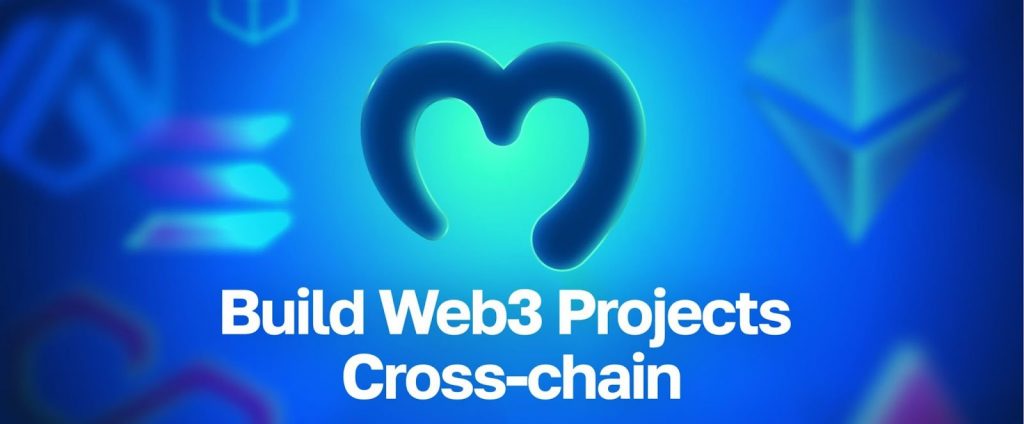
So, if you want to take your projects to the next level, sign up with Moralis. You can create an account for free, and you’ll gain instant access to our premier suite of Web3 development tools!
Why Did Crypto Crash Today?
The cryptocurrency market is dynamic, and the price of a token can change drastically at any given moment in time. Consequently, queries such as “Why did crypto crash today?” or “Why did crypto go up today?” are pretty common among traders.
Addressing these questions isn’t easy, making it challenging for casual investors to fully understand why coins pump or dump. Deciphering the many factors influencing specific price movements demands a comprehensive understanding of the market and a keen awareness of current news/trends within the industry.

These dynamic market conditions are inherent to the cryptocurrency space, creating information asymmetry for users not full-time in crypto. This, in turn, results in barriers to user interactions for anyone building cryptocurrency wallets, DEXs, portfolio trackers, or any other decentralized finance (DeFi) platform, as it’s challenging for developers to bridge this information gap. Now, however, there’s a reliable way for anyone building a dapp to inform their users of why crypto crashed or spiked – Moralis’ Why Did It Move API!
But what exactly is the Why Did It Move API, and how does it work?
For the answers to these queries, join us in the following subsections as we explore the intricacies of this tool!
Why Did It Move API – Crypto Market Intelligence with One Call
The Why Did It Move API from Moralis stands out as a unique crypto price movement API within the Web3 development space. It gives you one-sentence explanations for why cryptocurrencies are pumping or dumping on a given day. As such, while most APIs tell you when the price of a coin is increasing or decreasing, the Why Did It Move API takes it one step further, giving you an explanation for why the coin’s value is changing. This innovative feature is a game changer for anyone building DeFi platforms, adding a valuable layer of understanding to the raw data of price fluctuations!
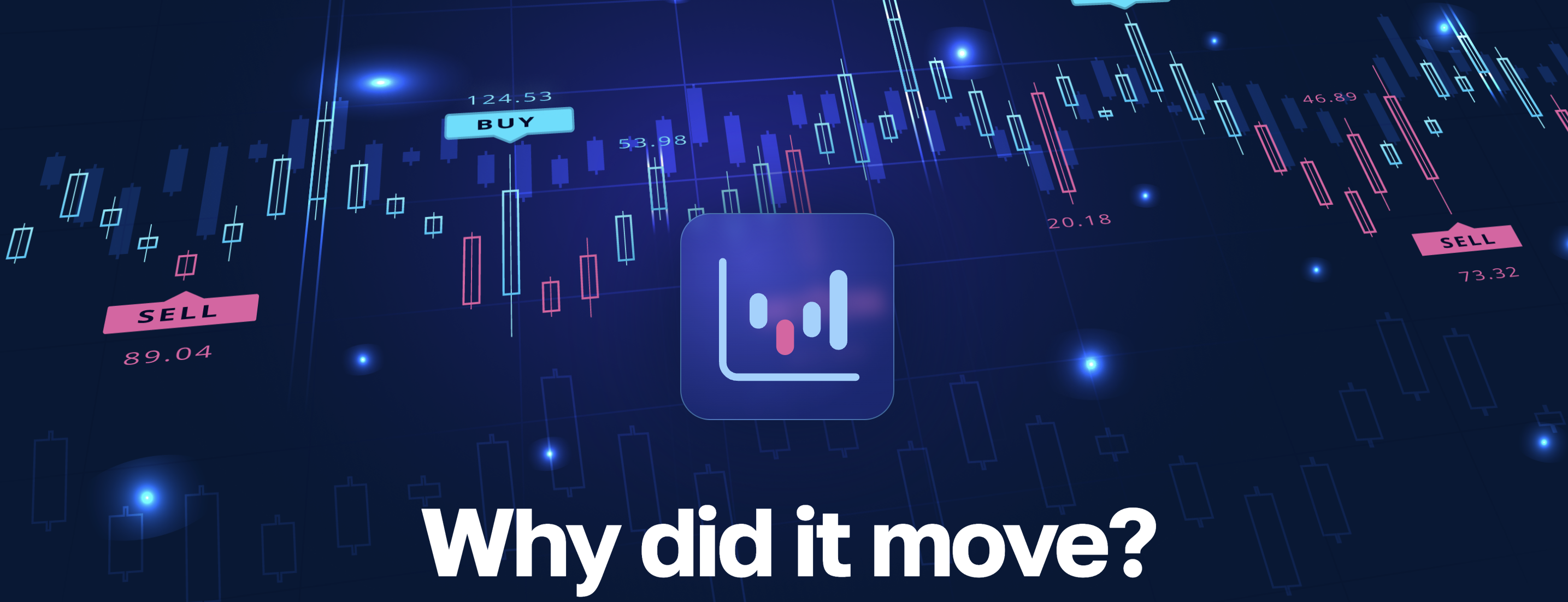
With a single call, you can use this API to query one-sentence news flashes for what’s behind the price actions of cryptocurrencies. With this data, you can, for instance, send engaging push notifications to your users that answer questions such as, ”Why did crypto crash today?” or ”Why did crypto go up today?”.
For instance, this is what it might look like:
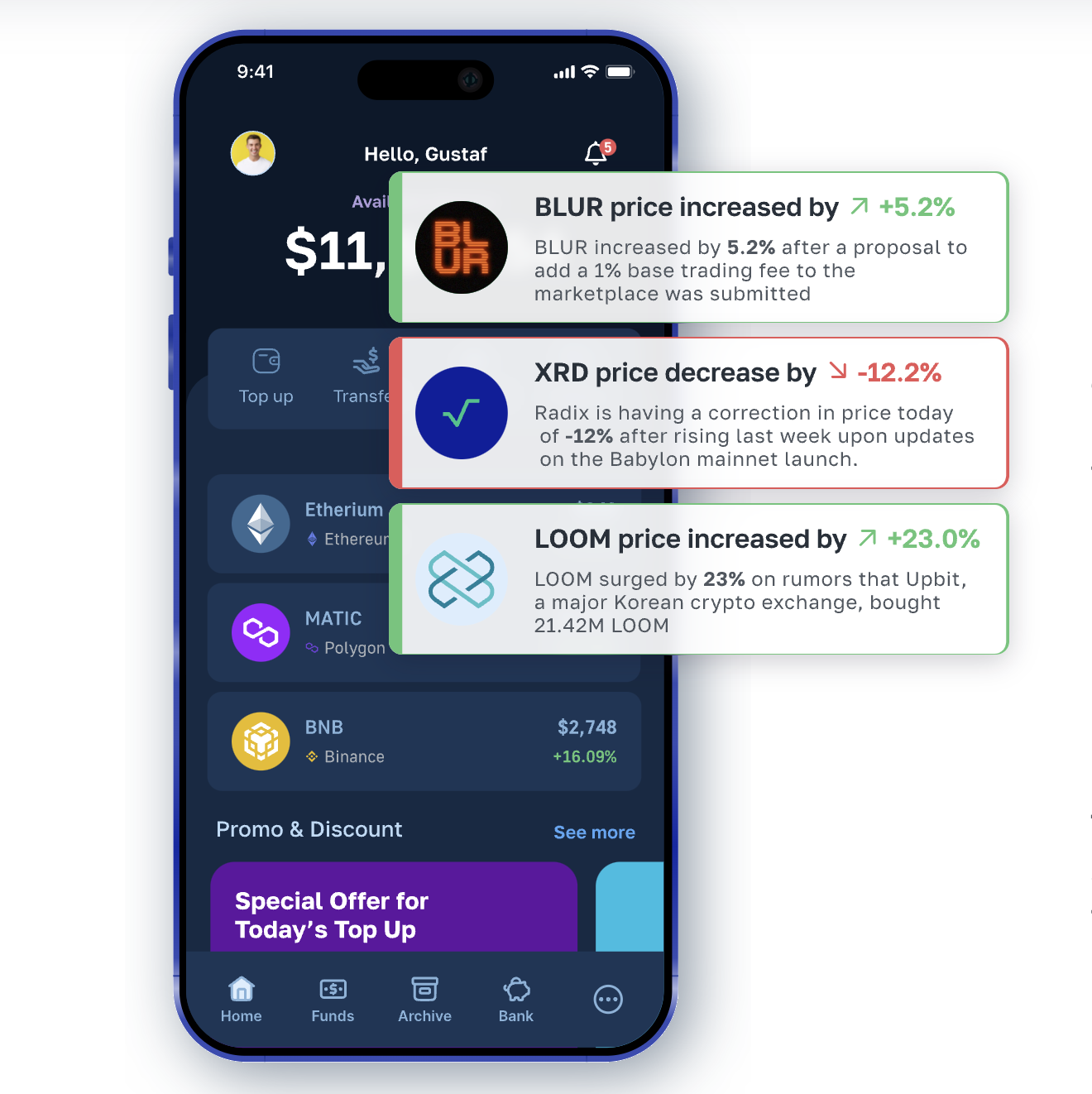
In return, you’ll be able to increase user engagement, provide higher customer value, and gain a significant competitive advantage.
So, while most dapps tell you when the price of a coin has moved, the Why Did It Move API allows you to create engaging platforms that stand out in the market by telling your users why a coin is increasing or decreasing in price.
That gives you an overview of the Why Did It Move API. In the next section, we’ll briefly explain how this industry-leading tool works!
How Does Moralis’ Why Did It Move (WDIM) API Work?
Moralis’ system continuously monitors 100+ of the industry’s top cryptocurrencies. At the onset of a coin significantly increasing or decreasing in value, our team thoroughly scans the market for any news that may have initiated the price action. If they find a match, they type up a one-sentence news flash explaining why the price moved. From here, you can then use the Why Did It Move API to query these explanations and seamlessly serve them to your users!

But exactly what cryptocurrencies are covered?
The Why Did It Move API selectively covers cryptocurrencies with a market capitalization exceeding $300 million. This limit ensures that all major players with noteworthy market influence are covered. Furthermore, with this limit, the Why Did It Move API supports approximately 170 assets at any given time. However, since market capitalizations fluctuate, the exact number of assets covered also changes.
Benefits of Using the API
The API provides loads of benefits, and in this section, we’ll explore three prominent examples:
- Real-Time Data: With the API, you have instant access to real-time, one-sentence explanations of what’s behind the price action of a coin. Consequently, as soon as crypto prices drastically change, you’ll have brief news flashes ready at a moment’s notice.
- Historical Data: The API lets you query all past events of a specific coin. In turn, you get historical insights into how and why cryptocurrencies increased or decreased in value.
- Competitive Advantage: You’ll gain a significant competitive advantage by providing unique, in-depth insight into the market. This allows your users to answer questions like, ”Why did crypto crash today?” or ”Why did crypto go up today?”.

That gives you an overview of why you should leverage the Why Did It Move API. In the next section, we’ll show you how to use this industry-leading tool!
Why Did Crypto Crash Today? How to Use the Why Did It Move API Tutorial
Using the Why Did It Move API is super simple. To get the one-sentence explanations for why cryptocurrencies are pumping or dumping, you just need a single call to the https://wdim.moralis.io/api/v1/news endpoint. You can find an example of what it might look like below:
// Dependencies to install: // $ npm install node-fetch --save // add "type": "module" to package.json import fetch from 'node-fetch'; const options = { method: 'GET', headers: { accept: 'application/json', 'Authorization': 'Bearer YOUR_API_KEY' }, }; fetch('https://wdim.moralis.io/api/v1/news', options) .then(response => response.json()) .then(response => console.log(response)) .catch(err => console.error(err)); Before calling the code, all you have to do is add your Moralis API key by replacing YOUR_API_KEY. From there, once you call the https://wdim.moralis.io/api/v1/news endpoint, you’ll get a response looking something like this:
{ //… "page": "1", "result": { "id": 1, "token_address": "0x046eee2cc3188071c02bfc1745a6b17c656e3f3d", "token_symbol": "RLB", "token_name": "Rollbit Coin", "chain": "ETH", "change_in_percent": 11, "headline": "On-chain volume shows heavy wallets accumulating RLB, leading to an 11% increase today.", "time_of_price_movement": "2023-10-13T12:00:00.000Z", "movement": "Positive", "updated_at": "2021-10-11T00:00:00.000Z", "created_at": "2021-10-11T00:00:00.000Z" } //… } You can also customize the query further by adding additional parameters, such as from_date and to_date, to only get news between two specific dates. But to learn more about this, check out the official Why Did It Move API documentation page!
Why Did It Move API Use Cases
The Why Did It Move API has loads of use cases, and in this section, we’ll briefly explore three examples:
- Real-Time Notifications: With the WDIM API, you can seamlessly integrate real-time notifications into your dapps that answer questions like ”Why did crypto crash today?” or ”Why is crypto up today?”. This can help boost engagement, ensuring that your customers return to use your product. Moreover, the Why Did It Move API is fully compatible with any push notification system.
- News Feeds: With access to both real-time and past news flashes, you can seamlessly add news feeds to your projects to keep users in the loop. This will give them an overview of the current market, along with historical insight.
- Timelines: With historical insight into past events, you can also leverage the Why Did It Move API to create individual timelines for specific coins. In doing so, you can give unique historical insight to your users, which can be valuable information when investing.

However, this only scratches the surface of what’s possible with the Why Did It Move API. All that’s limiting you is your imagination!
Case Study: How Delta Uses the Why Did It Move API for Crypto Insights
One platform already leveraging the Why Did It Move API to let users know why the crypto market is moving is Delta. Delta is an industry-leading portfolio tracker that allows you to monitor all your digital assets, including cryptocurrencies, NFTs, stocks, etc.
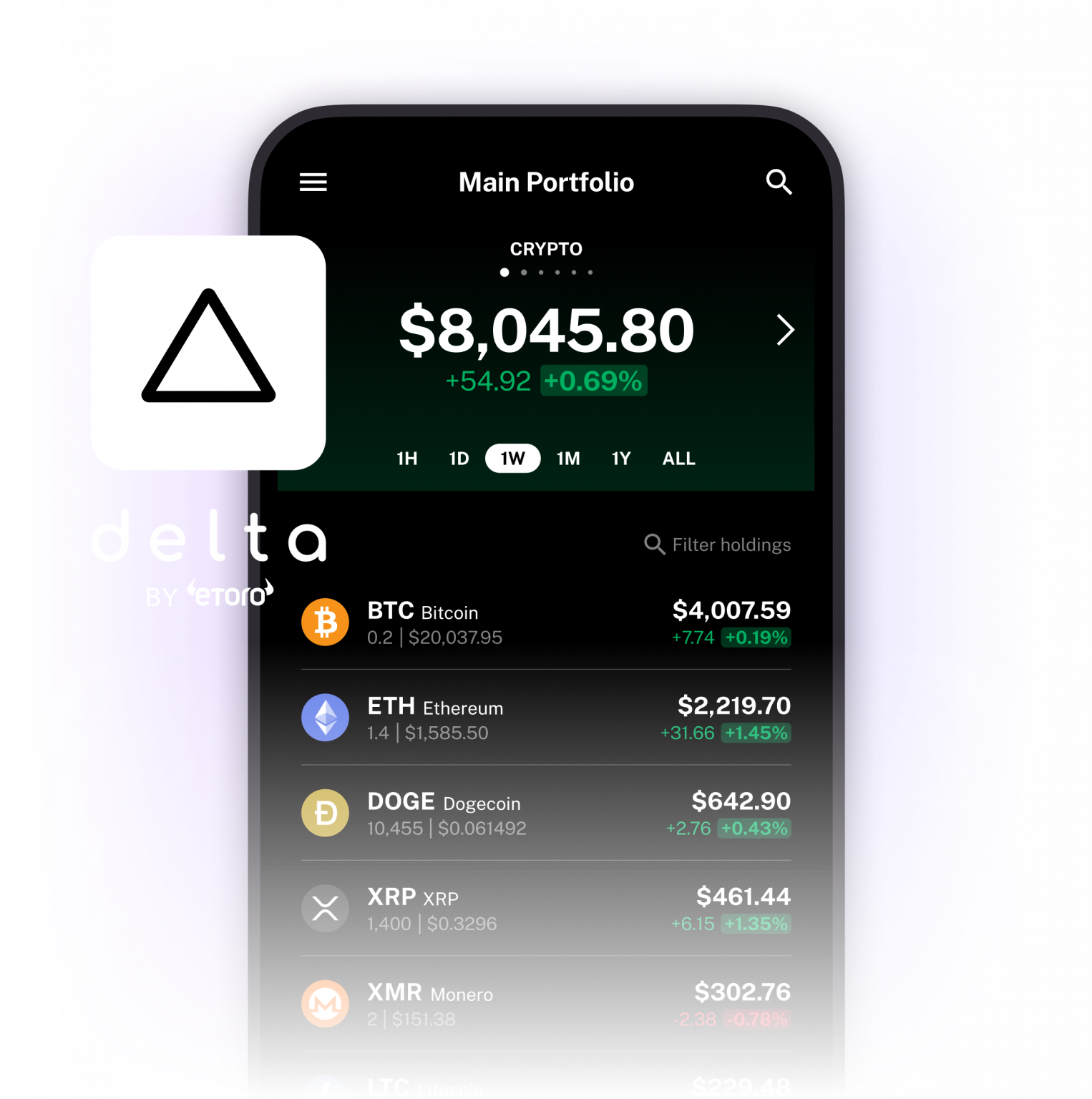
Delta uses the Why Did It Move API to give their Pro users real-time and historical explanations for why cryptocurrencies increased or decreased in price. By providing this feature, Delta has been able to boost the value of its product offering and increase user engagement.
As a result of using the WDIM API, Delta has also been able to sell more Pro plan subscriptions. This has led to an increase in the platform’s overall revenue!
So, if you also want to improve the user experience of your platform and increase engagement, check out the WDIM API!
Exploring Moralis’ Web3 APIs
Moralis is an industry-leading Web3 API provider. Within Moralis’ diverse toolset, you’ll find more than ten APIs for different use cases. Some prominent examples include the Wallet API, Token API, NFT API, and many others. As such, it doesn’t matter if you’re looking to build a cryptocurrency wallet, token explorer, NFT marketplace, or any other Web3 platform; Moralis has got you covered!

But why should you use Moralis?
- Industry-Leading Response Times: Moralis’ APIs offer industry-leading response times, allowing you to optimize the performance of your Web3 projects.
- Build Faster: Moralis enables you to accelerate the development of your dapps. With its tools, you can reduce the average time to market for a project by a staggering 83%.
- Cross-Chain Compatibility: Moralis’ premier APIs are cross-chain compatible, allowing you to build dapps across the biggest blockchains. This includes Ethereum, BNB Smart Chain (BSC), Solana, and all major ETH layer-2 networks.
Here’s a list of some of our Web3 APIs:
- Wallet API
- Token API
- Streams API
- Discovery API
- Blockchain API
- DeFi API
- Price API
To explore the interfaces above in further detail, check out our official Web3 API page!
Also, are you aware that you can access the APIs above for free? Just sign up with Moralis, and you’ll get instant access to our premier Web3 development suite!
Summary: Why Did Crypto Crash Today?
With the high volatility of the crypto market, the price of a token can change drastically at any moment. As such, traders frequently ask questions such as, “Why did crypto crash today?” or “Why did crypto go up today?”. Consequently, this results in barriers to user interactions for Web3 developers, as traders don’t generally get the full picture as to why the price of cryptocurrencies moves. Fortunately, there’s now a way for you to inform your users of why cryptocurrencies crashed or spiked: Moralis’ Why Did It Move API!

The Why Did It Move API is a unique tool that gives you access to one-sentence explanations for why cryptocurrencies are pumping or dumping. With this data, you can inform your users not only when the price of cryptocurrencies increases but also explain why.
By implementing this functionality into your DeFi projects, you can increase user engagement and improve the value of your product. It will also give your platform a significant competitive advantage!
If you liked this guide, consider reading more interesting content here at Moralis. For instance, explore the Polygon ecosystem or dive into the Ethereum ecosystem in 2024.
Also, if you want to take your Web3 projects to the next level, don’t forget to sign up with Moralis. You can set up an account for free, and you’ll be able to build dapps faster and more efficiently!
Read More: moralis.io

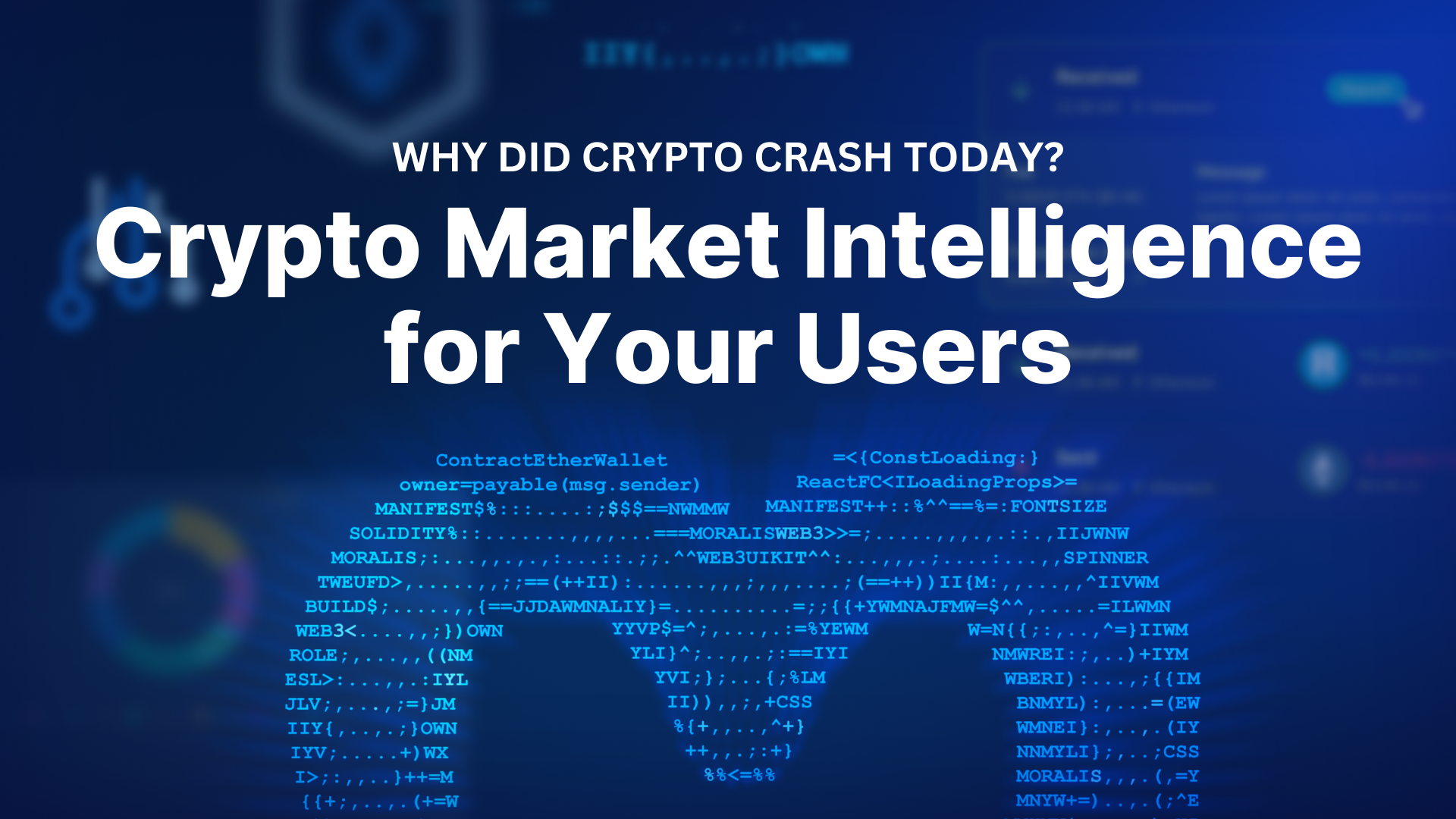







 Bitcoin
Bitcoin  Ethereum
Ethereum  Tether
Tether  XRP
XRP  Solana
Solana  USDC
USDC  TRON
TRON  Dogecoin
Dogecoin  Cardano
Cardano  Lido Staked Ether
Lido Staked Ether  Wrapped Bitcoin
Wrapped Bitcoin  Hyperliquid
Hyperliquid  Wrapped stETH
Wrapped stETH  Sui
Sui  Chainlink
Chainlink  LEO Token
LEO Token  Stellar
Stellar  Avalanche
Avalanche  Bitcoin Cash
Bitcoin Cash  Toncoin
Toncoin  Shiba Inu
Shiba Inu  USDS
USDS  Hedera
Hedera  WETH
WETH  Litecoin
Litecoin  Wrapped eETH
Wrapped eETH  Binance Bridged USDT (BNB Smart Chain)
Binance Bridged USDT (BNB Smart Chain)  Monero
Monero  Polkadot
Polkadot  Ethena USDe
Ethena USDe  Bitget Token
Bitget Token  Coinbase Wrapped BTC
Coinbase Wrapped BTC  Pi Network
Pi Network  Pepe
Pepe  WhiteBIT Coin
WhiteBIT Coin  Aave
Aave  Uniswap
Uniswap  Dai
Dai  Ethena Staked USDe
Ethena Staked USDe  Bittensor
Bittensor  OKB
OKB  Cronos
Cronos  BlackRock USD Institutional Digital Liquidity Fund
BlackRock USD Institutional Digital Liquidity Fund  Aptos
Aptos  NEAR Protocol
NEAR Protocol  Jito Staked SOL
Jito Staked SOL  Internet Computer
Internet Computer  sUSDS
sUSDS  Ethereum Classic
Ethereum Classic